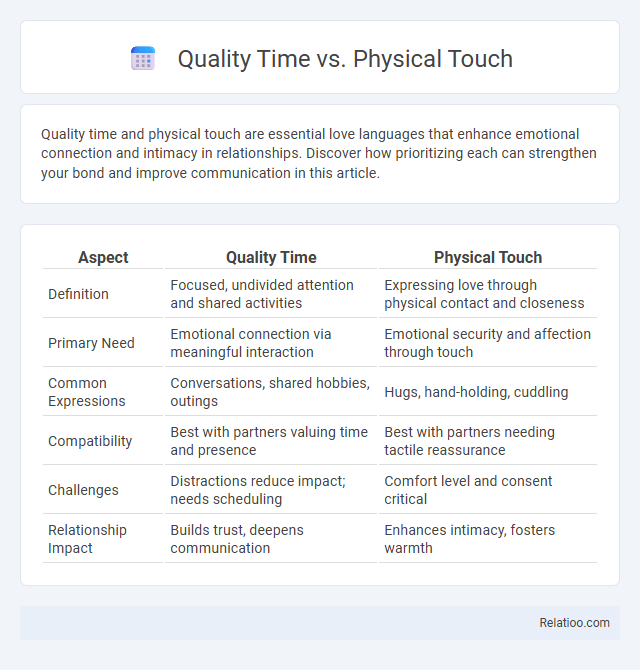Quality time and physical touch are essential love languages that enhance emotional connection and intimacy in relationships. Discover how prioritizing each can strengthen your bond and improve communication in this article.
Table of Comparison
| Aspect | Quality Time | Physical Touch |
|---|---|---|
| Definition | Focused, undivided attention and shared activities | Expressing love through physical contact and closeness |
| Primary Need | Emotional connection via meaningful interaction | Emotional security and affection through touch |
| Common Expressions | Conversations, shared hobbies, outings | Hugs, hand-holding, cuddling |
| Compatibility | Best with partners valuing time and presence | Best with partners needing tactile reassurance |
| Challenges | Distractions reduce impact; needs scheduling | Comfort level and consent critical |
| Relationship Impact | Builds trust, deepens communication | Enhances intimacy, fosters warmth |
Understanding Love Languages: Quality Time vs Physical Touch
Understanding love languages is essential for nurturing relationships, with Quality Time and Physical Touch often being primary expressions of affection. Quality Time emphasizes undivided attention and meaningful interactions, fostering emotional connection through shared experiences and active listening. Physical Touch conveys love through tactile gestures such as hugs, holding hands, and gentle touches, strengthening intimacy and emotional bonds through physical closeness.
Defining Quality Time in Relationships
Quality Time in relationships means giving your full, undivided attention to your partner, fostering deep connection through meaningful interactions. Unlike Physical Touch, which communicates love through tactile gestures, Quality Time centers on engagement and presence, enhancing emotional intimacy. Understanding your partner's preferred love language helps you tailor your efforts, ensuring that Your expressions of care resonate authentically.
The Power of Physical Touch in Emotional Connection
Physical touch serves as a powerful love language that strengthens emotional connections by releasing oxytocin, the bonding hormone, which fosters trust and reduces stress. You can enhance relationships by incorporating hugs, hand-holding, or gentle touches that convey care and support without words. This nonverbal communication often deepens intimacy and helps partners feel valued and emotionally secure.
Psychological Benefits of Quality Time
Quality Time as a primary love language fosters deeper emotional connections by encouraging undistracted, meaningful interactions that enhance relationship satisfaction. Psychological benefits include increased feelings of security, validation, and mutual understanding, which reduce stress and promote emotional resilience. Unlike Physical Touch, which primarily triggers oxytocin release, Quality Time strengthens communication and empathy, laying a foundation for long-term relational health.
How Physical Touch Affects Relationship Satisfaction
Physical touch as a love language profoundly influences relationship satisfaction by fostering emotional intimacy and strengthening bonds through nonverbal communication. Couples who frequently engage in affectionate touch, such as holding hands or hugging, report higher levels of trust, security, and overall happiness in their relationships. Research indicates that physical touch activates oxytocin release, which reduces stress and enhances feelings of closeness, making it a critical factor in sustaining long-term relationship satisfaction.
Recognizing Your Partner’s Primary Love Language
Recognizing your partner's primary love language, whether Quality Time, Physical Touch, or another form, enhances emotional connection and relationship satisfaction. Quality Time involves undivided attention and shared experiences, while Physical Touch emphasizes comfort and affection through gestures like hugging and holding hands. Understanding and responding to these love languages fosters deeper intimacy and effective communication between partners.
Challenges of Balancing Quality Time and Physical Touch
Balancing Quality Time and Physical Touch presents unique challenges, as each love language requires distinct expressions of affection that cater to different emotional needs. You may find that spending meaningful moments together becomes complicated if physical touch is your partner's primary love language but your schedules limit close contact. Understanding and adapting to these differences is essential to nurturing intimacy and ensuring both partners feel valued and connected.
Improving Communication about Emotional Needs
Quality Time, Physical Touch, and other love languages play a crucial role in improving communication about emotional needs by providing clear expressions of affection that resonate uniquely with each individual. Recognizing and responding to a partner's preferred love language enhances understanding and reduces misinterpretations, fostering deeper emotional connection and trust. Tailoring interactions according to these love languages enables more effective emotional support and strengthens relational bonds.
Practical Tips for Strengthening Bonds through Quality Time
Quality Time as a love language emphasizes focused, undistracted moments together to deepen emotional connections. Practical tips for strengthening bonds through Quality Time include scheduling regular, technology-free activities such as shared meals, walks, or hobby sessions that foster meaningful interaction. Consistent prioritization of presence and active listening creates a supportive environment where partners feel valued and understood.
Enhancing Intimacy with Meaningful Physical Touch
Enhancing intimacy with meaningful physical touch leverages the powerful connection between your love language and emotional expression, strengthening bonds beyond words. By recognizing that physical touch is a primary love language for many, you can deepen your relationship through intentional gestures like holding hands, gentle embraces, or comforting touches. Prioritizing quality time enriched with sincere physical contact fosters trust, emotional security, and a lasting sense of closeness.

Infographic: Quality Time vs Physical Touch
 relatioo.com
relatioo.com